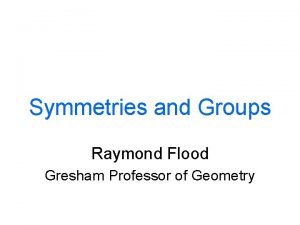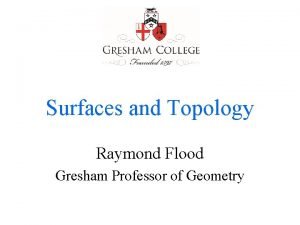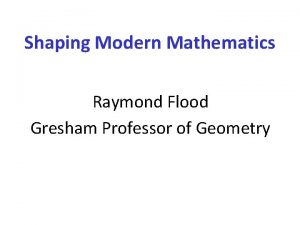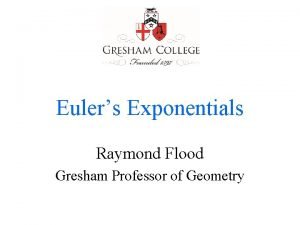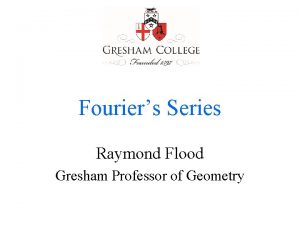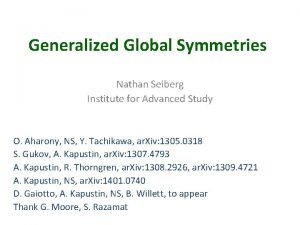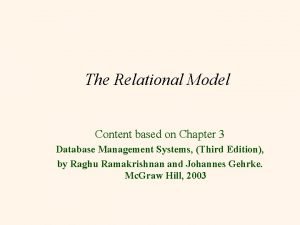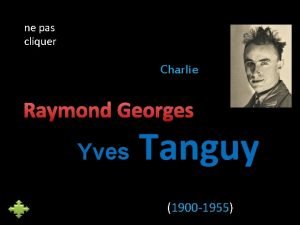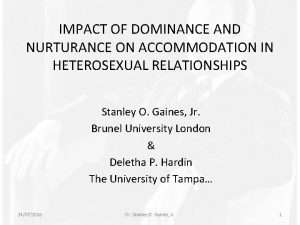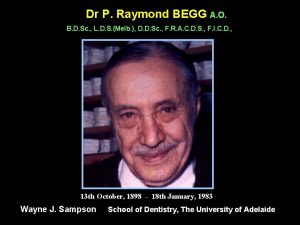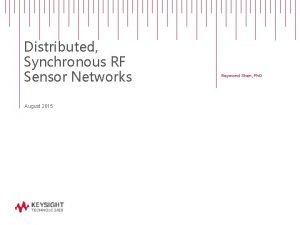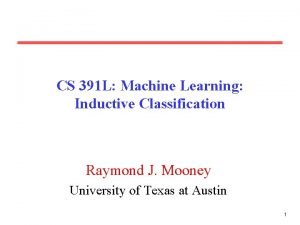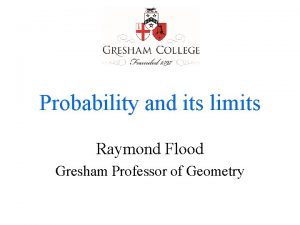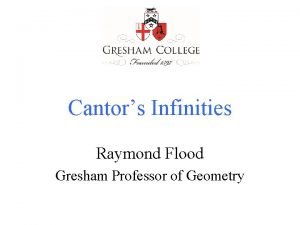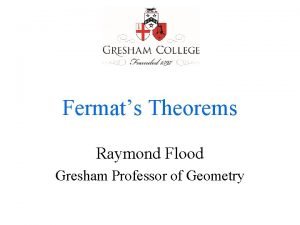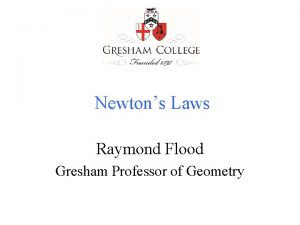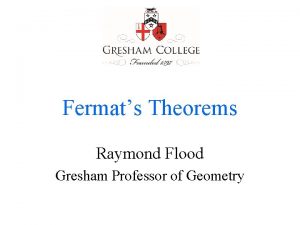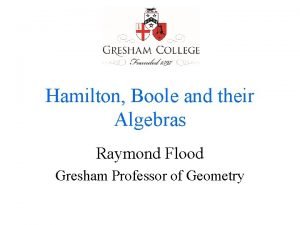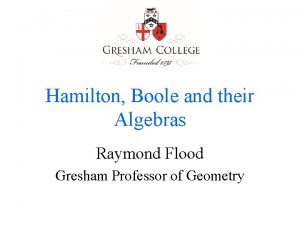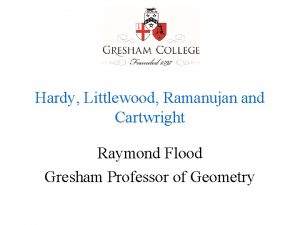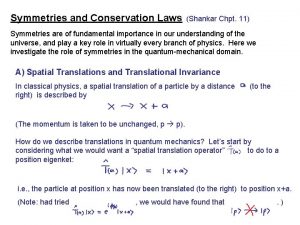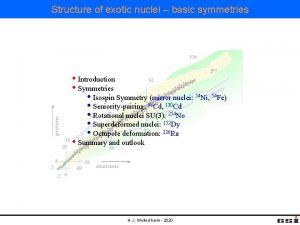Symmetries and Groups Raymond Flood Gresham Professor of





































- Slides: 37

Symmetries and Groups Raymond Flood Gresham Professor of Geometry

Overview • Group of Symmetries of the equilateral triangle • Compare the group of symmetries of a square and a rectangle • Symmetries of the platonic solids • Subgroups and Lagrange’s Theorem. • Modular Arithmetic and Fermat’s Little Theorem. • RSA encryption

Equilateral triangle

Equilateral triangle with labels 1 2 3

The Identity symmetry, I, of the equilateral triangle 1 I 2 3

R is the transformation rotate by 120° anticlockwise 3 1 R 2 3 1 2

R 2 is the transformation rotate by 240° anticlockwise 1 R R 2 2 3 3 1 2 3 1

R 3 is the transformation rotate by 360° anticlockwise It is the same as the identity I 1 3 2 1 R R 2 2 3 3 1 2 3 1

T is the transformation that turns the triangle over, keeping the top vertex fixed. 1 1 T 2 3 3 2

One symmetry transformation followed by another symmetry transformation is a symmetry transformation, Example of TR 1 3 3 R 2 3 T 1 2 2 1 3 So TR is the same as turning over leaving the bottom left vertex fixed 2 1

One symmetry transformation followed by another symmetry transformation is a symmetry transformation, example of RT 1 1 2 T 2 3 R 3 2 So RT is the same as turning over leaving the bottom right vertex fixed 1 2 1 3 3

TR is not equal to RT 3 TR is 1 2 2 RT is 3 1

Six symmetries of the equilateral triangle • I: Do nothing • R: rotate 120° anticlockwise about the centre of the triangle • R 2: rotate 240° anticlockwise about the centre of the triangle • T: turns the triangle over, keeping the line joining the top vertex to the centre fixed • TR: turns the triangle over, keeping the line joining the bottom left vertex to the centre fixed • RT: turns the triangle over, keeping the line joining the bottom right vertex to the centre fixed.

Do first I R R 2 T RT TR Composition table for the symmetries of the equilateral triangle. I I R R 2 R R R 2 I R T T TR RT RT RT T TR TR TR RT T T RT TR T RT I R 2 R R I R 2 R I (TR)R 2 = TR 3 = TI = T

Arthur Cayley 1821– 95

Do first I R R 2 T RT TR Composition table for the symmetries of the equilateral triangle I I R R 2 R R R 2 I R T T TR RT RT RT T TR TR TR RT T T RT TR T RT I R 2 R R I R 2 R I Two elements of order 3: Three elements of order 2: One element of order 1: R and R 2 T, RT and TR I, the identity

The Symmetries of an equilateral triangle form a group • There is a way of combining two symmetries and when we do the combining we get another symmetry. • There is a symmetry, called the identity, which when combined with any other leaves it unchanged. • Every symmetry has an inverse, i. e. another symmetry so that when the two are combined you get the identity. • Combining symmetries is associative so that if A, B and C are three symmetries then (AB)C = A(BC)

A group is a set G together with an operation * that combines any two elements g and h of G to give an element written g*h of G. An Identity exists: There is a special element in G called the identity written I with the property I*g = g and g*I = g for all g in G. Inverses exist: For every g in G there is a h in G with g*h = I and h*g = I Associative law: For any g, h and k in G

r is rotating 60° anticlockwise about the centre The Symmetry group has the 6 elements: 2 3 4 5

r is rotating 60° anticlockwise about the centre 2 3 4 5 I r r 2 r 3 r 4 r 5 I I r r 2 r 3 r 4 r 5 r r 2 The Symmetry group has the 6 elements: {I, r, r 2, r 3, r 4, r 5} r and r 5 of order 6 r 2 and r 4 of order 3 of order 2 r r 3 r 4 r 5 r r 2 r 3 r 4 r 5

Abelian groups are groups in which the order of combining elements does not matter. Named after Niels Henrik Abel 1802– 1829

ABEL PRIZEWINNERS • 2003: Jean-Pierre Serre (France) • 2004: Michael Atiyah (UK) and Isadore Singer (USA) • 2005: Peter Lax (Hungary/USA) • 2006: Lennart Carleson (Sweden) • 2007: Srinivasa Varadhan (India/USA) • 2008: John Thompson (USA) and Jacques Tits (France) • 2009: Mikhail Gromov (Russia) • 2010: John Tate (USA) • 2011: John Milnor (USA)

Symmetries of a square

Symmetries of a rectangle Identity, I Rotate by 180°, R Turn about vertical axis, V Turn about Horizontal axis, H

Symmetries of a rectangle Rotate by 180°, R Identity, I Turn about vertical axis, V Turn about Horizontal axis, H I R V H I I R V H R R I H V V V H I R H H V R I

The Five regular or Platonic Solids Tetrahedron – four faces each an equilateral triangle Cube – six faces, each a square Octahedron – eight faces each an equilateral triangle Dodecahedron – twelve faces each a regular pentagon Icosahedron – twenty

Symmetries of the Five regular or Platonic Solids SOLID Number of Faces, F Number of edges in a face, E Number of symmetries = 2 EF Tetrahedron 4 3 24 Cube 6 4 48 Octahedron 8 3 48 Dodecahedron 12 5 120 Icosahedron 20 3 120 Centres of the faces of a cube form the vertices of an octahedron Centres of the faces of an octahedron form the vertices of a

Subgroup – a little group inside the big group A subgroup of a group is a subset of the group elements which is itself a group under the group operation. Below {I, R, R 2} is a subgroup of the group of symmetries of the equilateral triangle. Do first I R R 2 T RT TR I I R R 2 R R R 2 I R T T TR RT RT RT T TR TR TR RT T T RT TR T RT I R 2 R R I R 2 R I

Subgroup – a little group inside the big group A subgroup of a group is a subset of the group elements which is itself a group under the group operation. Below {I, T} is a subgroup of the group of symmetries of the equilateral triangle. Do first I R R 2 T RT TR I I R R 2 R R R 2 I R T T TR RT RT RT T TR TR TR RT T T RT TR T RT I R 2 R R I R 2 R I

Lagrange’s theorem Definition: the order of a group is the number of elements it contains. Symmetry group of equilateral triangle has order 6 Symmetry group of square has order 8 Symmetry group of rectangle has order 4 Lagrange’s Theorem: The order of a subgroup divides the order of the group. Example: The group of symmetries of the equilateral triangle has order 6 and the subgroups {I, R, R 2} has order 3 which divides 6 and {I, T} has order 2 which divides 6.

The order of an element divides the order of the group. Consider the subset: {g, g times g times, … , identi it forms a subgroup with size the order of g I R R 2 I I R R 2 R R R 2 I R T T TR RT RT RT T TR TR TR RT T T RT TR T RT I R 2 R R I R 2 R I Two elements of order 3: R and R 2 Three elements of order 2: T, RT and TR One element of order 1:

The order of an element divides the order of the group. Consequence: Denote the order of the group as G. In any group any element combined with itself G times will give the identity. Suppose the order of the group is 12, and the order of the element, g, is 4. Then g combined with itself 4 times gives the identity so g combined with itself 12 times will also

Remainders form a group under addition Pick integer n. The remainders are the remainders on dividing integers by n which are {0, 1, 2, … , n-1} Denote the group operation by defined as: a b is the remainder obtained when a + b is divided by n. Suppose n is 24: The group is {0, 1, 2, 3, 4, 5, 6, 7, 8, 9, 10, 11, 12, 13, 14, 15, 16, 17, 18, 19, 20, 21, 22, 23} 7 21 = 4 15 10 = 1

Non-zero remainders of a prime form a group under multiplication Pick a prime p. The group operation is : a b is the remainder obtained when a × b is divided by p. Example p = 7 Group is {1, 2, 3, 4, 5, 6} with operation So 2 5 = 3 4 4 = 2 The identity is 1. The inverse of 2 is 4, of 3 is 5, and of 6 is 6.

Fermat’s Little Theorem Pick any prime, p and any integer, k, smaller than p. Raise k to the power of p -1 and find its remainder on dividing by p. The answer is always 1 no matter what p is or k is! In any group any element combined with itself G times will give the identity. Pick your p = 17, k = 10 Then we know that 1017 – 1 = 1016 leaves a remainder of 1 when divided by 17. kp has the same remainder as k when divided by p for any prime p and integer k.

Non-zero remainders relatively prime to n under multiplication Suppose n is 35 = 5 x 7. The group, G, is then {1, 2, 3, 4, 6, 8, 9, 11, 12, 13, 16, 17, 18, 19, 22, 23, 24, 26, 27, 29, 31, 32, 33, 34} Its order is 24 = (p-1)(q-1) = 4 x 6 = 24 Any element of G raised to the power of 24 has a remainder of 1 Public key N and E on dividing by 35. Private key D In the RSA algorthm e and d are chosen so that ed=is. Mamultiple of 24 of plus 1 = Mmultiple of 24 M = 1 M = This shows Med 24 plus 1.

1 pm on Tuesdays at the Museum of London Butterflies, Chaos and Fractals Tuesday 17 September 2013 Public Key Cryptography: Secrecy in Public Tuesday 22 October 2013 Symmetries and Groups Tuesday 19 November 2013 Surfaces and Topology Tuesday 21 January 2014 Probability and its Limits Tuesday 18 February 2014 Modelling the Spread of Infectious Diseases Tuesday 18 March 2014
 Professor raymond flood
Professor raymond flood Professor raymond flood
Professor raymond flood Quickest descent
Quickest descent Gresham professor of geometry
Gresham professor of geometry Gresham professor of geometry
Gresham professor of geometry Pyramid planes of symmetry
Pyramid planes of symmetry Generalized global symmetries
Generalized global symmetries Seigniorage
Seigniorage Gresham’s law
Gresham’s law Promotion from assistant to associate professor
Promotion from assistant to associate professor How are ethnic groups and religious groups related
How are ethnic groups and religious groups related Raymond boyce and donald chamberlin
Raymond boyce and donald chamberlin Tragedy and contemporary ideas
Tragedy and contemporary ideas What is the tone of raymond's run
What is the tone of raymond's run Raymond williams and stuart hall
Raymond williams and stuart hall Advantages and disadvantages of floods
Advantages and disadvantages of floods Why do the llanos in colombia and venezuela flood easily
Why do the llanos in colombia and venezuela flood easily Please be quiet. i (try) to sleep
Please be quiet. i (try) to sleep Carver middle school dress code
Carver middle school dress code Dolphus raymond quotes
Dolphus raymond quotes Dyberport
Dyberport Raymond moffatt
Raymond moffatt Setting in raymond's run
Setting in raymond's run Characters in raymond's run
Characters in raymond's run Raymond devos courir
Raymond devos courir Personality psychology
Personality psychology Mintzberg outlined three categories of managerial roles:
Mintzberg outlined three categories of managerial roles: Stuart hall 1981
Stuart hall 1981 Raymond georges yves tanguy
Raymond georges yves tanguy Ent raymond naves
Ent raymond naves Raymond inmon wikipedia
Raymond inmon wikipedia Roshana wickremaratchi
Roshana wickremaratchi Raymond buys
Raymond buys Civics 360 .org
Civics 360 .org Raymond hettinger wikipedia
Raymond hettinger wikipedia Edgewise begg appliance
Edgewise begg appliance Raymond shen
Raymond shen Cs391l
Cs391l
